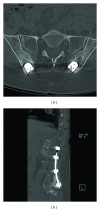Percutaneous iliac screws for minimally invasive spinal deformity surgery
- PMID: 22900162
- PMCID: PMC3414079
- DOI: 10.1155/2012/173685
Percutaneous iliac screws for minimally invasive spinal deformity surgery
Abstract
Introduction. Adult spinal deformity (ASD) surgeries carry significant morbidity, and this has led many surgeons to apply minimally invasive surgery (MIS) techniques to reduce the blood loss, infections, and other peri-operative complications. A spectrum of techniques for MIS correction of ASD has thus evolved, most recently the application of percutaneous iliac screws. Methods. Over an 18 months 10 patients with thoracolumbar scoliosis underwent MIS surgery. The mean age was 73 years (70% females). Patients were treated with multi-level facet osteotomies and interbody fusion using expandable cages followed by percutaneous screw fixation. Percutaneous iliac screws were placed bilaterally using the obturator outlet view to target the ischial body. Results. All patients were successfully instrumented without conversion to an open technique. Mean operative time was 302 minutes and the mean blood loss was 480 cc, with no intraoperative complications. A total of 20 screws were placed successfully as judged by CT scanning to confirm no bony violations. Complications included: two asymptomatic medial breaches at T10 and L5, and one patient requiring delayed epidural hematoma evacuation. Conclusions. Percutaneous iliac screws can be placed safely in patients with ASD. This MIS technique allows for successful caudal anchoring to stress-shield the sacrum and L5-S1 fusion site in long-segment constructs.
Figures





Similar articles
-
Improvement of sagittal balance and lumbar lordosis following less invasive adult spinal deformity surgery with expandable cages and percutaneous instrumentation.J Neurosurg Spine. 2013 Jan;18(1):4-12. doi: 10.3171/2012.9.SPINE111081. Epub 2012 Oct 26. J Neurosurg Spine. 2013. PMID: 23101944
-
Preoperative Robotics Planning Facilitates Complex Construct Design in Robot-Assisted Minimally Invasive Adult Spinal Deformity Surgery-A Preliminary Experience.J Clin Med. 2024 Mar 22;13(7):1829. doi: 10.3390/jcm13071829. J Clin Med. 2024. PMID: 38610594 Free PMC article.
-
Complication rates associated with open versus percutaneous pedicle screw instrumentation among patients undergoing minimally invasive interbody fusion for adult spinal deformity.Neurosurg Focus. 2017 Dec;43(6):E7. doi: 10.3171/2017.8.FOCUS17479. Neurosurg Focus. 2017. PMID: 29191098
-
Use of anteroposterior view fluoroscopy for targeting percutaneous pedicle screws in cases of spinal deformity with axial rotation.J Neurosurg Spine. 2014 Nov;21(5):826-32. doi: 10.3171/2014.7.SPINE13846. Epub 2014 Aug 29. J Neurosurg Spine. 2014. PMID: 25170657
-
A systematic review of pseudarthrosis and reoperation rates in minimally invasive adult spinal deformity correction.World Neurosurg X. 2024 Feb 25;22:100282. doi: 10.1016/j.wnsx.2024.100282. eCollection 2024 Apr. World Neurosurg X. 2024. PMID: 38444873 Free PMC article. Review.
Cited by
-
Sacropelvic fixation versus fusion to the sacrum for spondylodesis in multilevel degenerative spine disease.Eur Spine J. 2014 May;23(5):1013-20. doi: 10.1007/s00586-014-3165-6. Epub 2014 Jan 22. Eur Spine J. 2014. PMID: 24448893
-
A Comparative Study of Functional Outcomes in Unstable Pelvic Ring Fractures Treated With Internal Fixator (INFIX) With and Without Sacroiliac Joint Screw Fixation.Cureus. 2024 May 14;16(5):e60279. doi: 10.7759/cureus.60279. eCollection 2024 May. Cureus. 2024. PMID: 38872681 Free PMC article.
-
Reoperation rates in minimally invasive, hybrid and open surgical treatment for adult spinal deformity with minimum 2-year follow-up.Eur Spine J. 2016 Aug;25(8):2605-11. doi: 10.1007/s00586-016-4443-2. Epub 2016 Feb 24. Eur Spine J. 2016. PMID: 26909764
-
Functional Outcome of Internal Fixation (INFIX) in Anterior Pelvic Ring Fractures.Cureus. 2023 Mar 14;15(3):e36134. doi: 10.7759/cureus.36134. eCollection 2023 Mar. Cureus. 2023. PMID: 37065289 Free PMC article.
-
A new individually designed 3D printing guide plate-assisted internal fixator (INFIX) surgery for the treatment of pelvic fractures.J Orthop Surg Res. 2025 Aug 19;20(1):770. doi: 10.1186/s13018-025-06125-z. J Orthop Surg Res. 2025. PMID: 40830964 Free PMC article. Review.
References
-
- Pateder DB, Gonzales RA, Kebaish KM, Cohen DB, Chang JY, Kostuik JP. Short-term mortality and its association with independent risk factors in adult spinal deformity surgery. Spine. 2008;33(11):1224–1228. - PubMed
-
- Smith JS, Shaffrey CI, Glassman SD, et al. Risk-benefit assessment of surgery for adult scoliosis: an analysis based on patient age. Spine. 2011;36(10):817–824. - PubMed
-
- Fehlings MG, Ibrahim GM. Spinal deformity. Journal of Neurosurgery. 2010;13(6):663–664. - PubMed
-
- Mummaneni PV, Dhall SS, Ondra SL, Mummaneni VP, Berven S. Pedicle subtraction osteotomy. Neurosurgery. 2008;63(3):A171–A176. - PubMed
-
- Bess S, Boachie-Adjei O, Burton D, et al. Pain and disability determine treatment modality for older patients with adult scoliosis, while deformity guides treatment for younger patients. Spine. 2009;34(20):2186–2190. - PubMed
LinkOut - more resources
Full Text Sources
Research Materials

